Muni provides accessible public transit to virtually every corner of San Francisco. Below is detailed information on the accessible features available on Muni buses, information on how to board the bus, and some friendly tips to follow as you ride with Muni.
1. Accessible Features
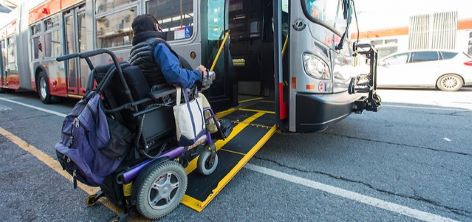
Wheelchair Ramps
Muni’s fleet of low-floor coaches is equipped with front door ramps. Because the ramp-equipped vehicles are low-floor, they allow level boarding when the bus is kneeled, and the ramp is deployed at curb and island stops.
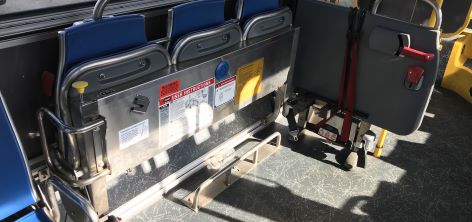
Securement Areas
Muni’s New Flyer buses have two wheelchair securement areas equipped with four-point securements and belts. On 40’ coaches, the first securement area is behind the operator and the second one is on the curb side of the vehicle adjacent to the rear door.
On 60’ coaches, the first securement area is next to the wheel well on the curb side of the vehicle. The second securement area is opposite the rear door.
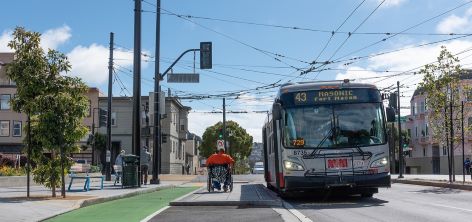
Kneelers
Kneelers lower the front of the bus by several inches, making it easier for customers to board, especially if boarding from the street.
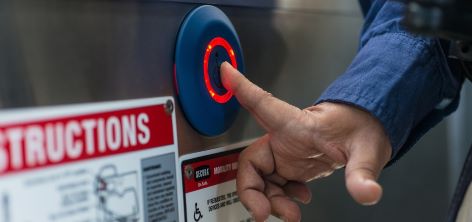
Accessible Stop Request
A blue button located under the flip seat can be used to let the driver know when a wheelchair user wants to get off.
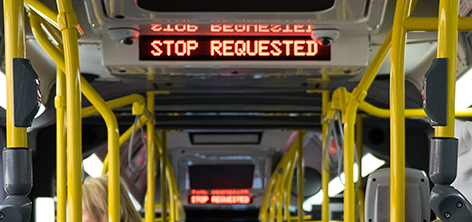
Stanchions
Vertical and horizontal poles with hanging straps for standing customers to hold on to for stability are provided throughout the vehicle.
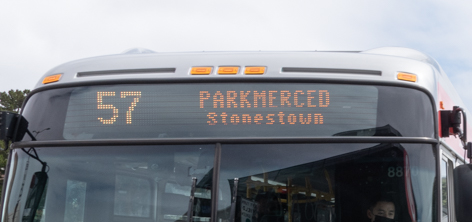
Destination Signs
On most vehicles, digital signs on the front, sides and rear display the line name and destination. A recorded voice announces the same information to waiting passengers whenever the doors open.
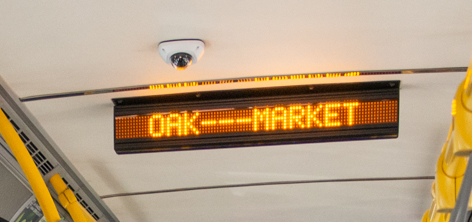
Automated Stop Announcements
On most vehicles, a recorded voice announces upcoming stops before arrival, while digital signs display the same information. Additionally, when a bus stops and opens its doors, a recorded voice announces the route and final destination.
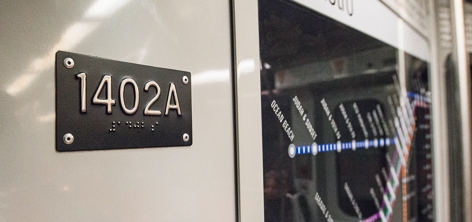
Tactile Vehicle Number
A metal plate with the coach number in braille and raised characters is installed on a panel behind the Operator’s compartment.

Priority Seating
All seats on the lower level of the coach are priority seats and are labeled with accessibility decals. A row of forward-facing priority seats is opposite the rear door. Customers are encouraged to yield priority seats to seniors and people with disabilities.
Note that there is a single flip-up seat labeled with a stroller decal that can accommodate strollers and small carts.
2. Boarding the Bus
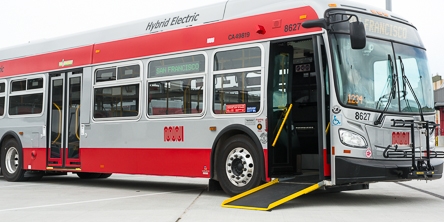
Using the Ramp
Be sure to position yourself so that the transit operator can see you as the bus approaches the stop. Please inform the operator that you need the ramp.
The ramp may be deployed at a curb or island stop or onto the street. The ramp will be nearly level when deployed for boarding at a curb or island. When deployed in the street the ramp slope will be steeper, and you should use extra caution. If you use a manual wheelchair and need help making it up or down the ramp safely, please ask the driver for assistance.
Note: There are some stops where wheelchair ramp deployment is not recommended. These stops are marked by a yellow rectangle with two triangles, painted on the street.
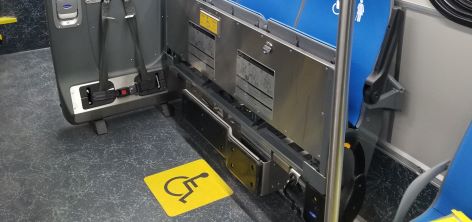
Using the Securement Area
The securement areas are created by lifting up the row of 3 aisle-facing seats in a designated securement area. Pull the yellow lever underneath the seats to raise them and ready the securement area. These areas are equipped with a four-point securement system and belts. It is Muni’s policy that customers secure their chair with the four-point securements. Inform the bus operator if you need assistance using the belts.
3. Customer Tips
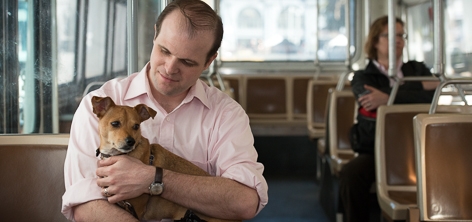
Service Animals
Service animals are allowed on all Muni buses. Service animals must be leashed and under the control of their owner at all times.
More Information:
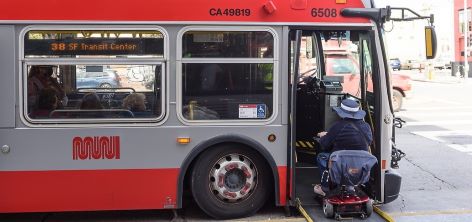
Wheelchairs and Other Mobility Devices
Muni is able to accommodate most mobility devices. As a general reference, Muni vehicles are able accommodate most mobility devices. The weight capacity of ramps is 600 lbs. and the securement area on the vehicle is 30" by 48". If you are concerned about whether your mobility device can be accommodated, please contact SFMTA Accessible Services at 415.646.2260.
Segways
Muni may be able to accommodate a Segway, when used as a mobility device. You will need a Permit. For more information on Segway accommodations, please call or contact Matthew West at 415.646.2753, or Matthew.West@SFMTA.com
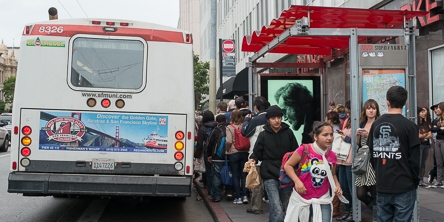
Crowds
Muni is most crowded on weekdays, during the morning and evening commute, which we refer to as our peak periods. Our morning "Peak" is from 6:30am - 9:00am, and our evening "Peak" is from 3:30pm - 7:00pm. Some of our busiest bus lines, such as the 8x, 14, 30, 38, 45, and 49 experience crowds all day long. If you do not want to encounter crowds, try your best to travel between 9am and 3pm, or after 7 at night.
Note: On crowded vehicles, the priority seats may already be occupied by seniors and people with disabilities or by other customers. Upon request, operators can ask passengers to give up their seats but cannot force them to do so. Be sure to keep grocery carts, luggage and other large items out of the aisle

Flag Stops
In residential areas and other low traffic locations, many stops are “Flag stops” where the bus will stop in the street rather than pull to the curb. At these stops you will need to leave the sidewalk and board directly from the street. Please watch for oncoming traffic when boarding or exiting the coach at these locations. Stay clear of the vehicle after exiting—do not cross the street in front of the bus.

Non-Accessible Stops
At stops on steep inclines and areas with narrow sidewalks we paint a yellow rectangle with two triangles on the street. This "Sawtooth Stop Bar" indicates that this stop is not accessible to people who use a mobility device. If you request to get off here, the operator will do their best to find a safe place to let you off, however this may be an area other than the designated bus stop.
Note: If the operator is unable to find a safe place to let you off, you may have to get off at the next stop.
Market Street: On Market Street, some stops are located on boarding islands in the middle of the street. These islands are too narrow to accommodate ramp deployment, making some stops inaccessible to people who use mobility devices. A map showing the accessible stops on Market Street is available.
For additional information on accessibility of the Muni system please see our Access Guide, although please note that the website may have more up-to-date information.